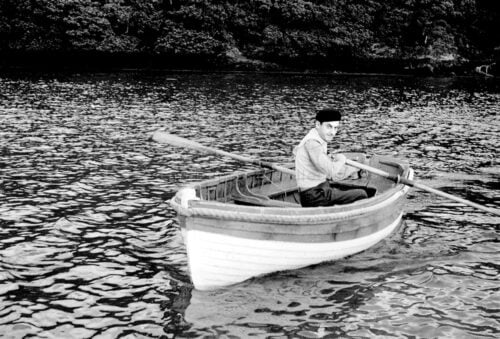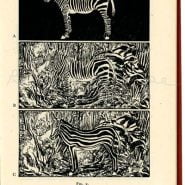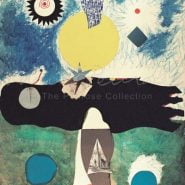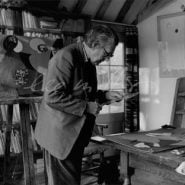Lee Miller and the Mermaid (Part 1)
Follow Lee Miller's footsteps through the liberation of Denmark, as written by her granddaughter Ami Bouhassane.
READ NOW








Born: 14 October 1900, St Johns Wood, London, England.
Died: 23 April 1984, Farleys House, Muddles Green, Chiddingly, East Sussex, England.
Roland is best known as a Surrealist artist and for his biography of his friend Picasso, ‘Picasso – his life and work’ (1958), followed by books on Joan Miró (1970), Man Ray (1975), Antoni Tàpies (1978), and his autobiography ‘Scrap Book, 1900 – 1981’(1981). He organised the highly acclaimed Picasso retrospective for the Tate Gallery in 1960, followed by other key exhibitions at the Tate and major galleries. He co-founded the ICA (Institute of Contemporary Art) in 1947 but returned to painting in the last decade of his life, with exhibitions of his collages in London, Paris and Brighton.
Roland’s early painting was much influenced by Max Ernst, from whom he learned the techniques of collage and frottage, but it was the Cubism of Braque and Picasso that gave him the key to his distinctive postcard collages.
The son of a Victorian portrait painter, Roland was educated at Cambridge before moving to France, where he lived from 1922 to 1936. Through his first wife, the surrealist poet Valentine Boué, Roland met the poets André Breton and Paul Éluard, who introduced him to the painters Max Ernst and Joan Miró. He joined the Surrealist movement in Paris, and on his return to London in 1936 organised the International Surrealist Exhibition with the poet David Gascoigne and the artist and writer E.L.T Mesens. This led to the formation of an English Surrealist movement in which Roland became a leading artist.
1936 also saw Roland establish at permanent base at 21 Downshire Hill in Hampstead, London, alongside his artist friends Henry Moore, Barbara Hepworth and Paul Nash, to name but a few. In 1937, during a stay in Paris, Roland met the photographer Lee Miller. The pair fell in love and began a long-distance love affair, which culminated in Lee moving to London in 1939 to be with Roland. They married after the war, and had their only child – a son named Antony, in 1947.
In 1938, Roland continued his role as a disruptor in the British art scene by taking over, with E.L.T Mesens, The London Gallery in Cork Street, where the pair showcased Surrealism and modern art. Famously, the gallery organized the 1938 British tour of Picasso’s Guernica and its associated works. A year later, the gallery published Roland’s surrealist image diary The Road is Wider than Long, which recorded a journey through Greece and Romania he had taken with Lee a year earlier.
Roland retained his Quaker pacifist beliefs during the Second World War, working as an ARP Warden and going on to design and lecture on camouflage for the Home Guard and Armed Forces.
Throughout his life, Roland was a dedicated and enthusiastic champion of new artists. Determined to bring international modernism to London, Roland, Mesens and Herbert Read founded the ICA in 1947 as a space for new and experimental art. Roland remained a guiding force at the ICA for thirty years.
In 1949, Roland purchased Farley Farm as a countryside retreat for his family. With Lee, Roland filled the farmhouse’s brightly painted walls with artworks, adding his own contribution in the form of a mural in the dining room inglenook fireplace. The house became a key meeting place for artists, with their friends visiting in droves. Picasso, Henry Moore, Leonora Carrington, Miró, Max Ernst and Dorothea Tanning are among the creatives who signed their names into the Farleys visitor book.
Roland was awarded a CBE in 1960 following the Picasso exhibition at the Tate. He was knighted in 1966 for his Services to Contemporary Art. In 1980 the University of Sussex honoured him with an Honorary Doctorate of Literature.
Roland died at Farleys on 23rd April 1984. Today, many of the rooms at Farleys have been restored, and the house, galleries and garden are open for tours between April and October.
View Roland Penrose’s work
14th October. Birth of Roland Algernon Penrose to parents James Doyle and Elizabeth Josephine Penrose and elder brothers Lionel and Alec in London, England.

Rolands younger brother Bernard, known as ‘Beacus’ is born.
Penrose family move to Oxhey Grange, Hertfordshire , England where Roland receives a strict Quaker upbringing.

Roland’s family are pacifists. Lionel and Alec register as conscientious objectors and serve with Friends Ambulance Unit on the Western Front.
Roland leaves school and joins the Friends Ambulance Unit being posted to Italy in the final days of the war.

Roland studies architecture at Queens College, Cambridge, England. He finds m0dern art more interesting and discovers the work of Picasso.

Roland moves to Paris. He studies painting, becoming increasingly interested in Surrealism, and befriends Man Ray.
Roland moves to South of France and has his first studio at Villa les Mimosas in Cassis-sur-Mer

Roland meets Valentine Boué, a French Surrealist Poet who introduces him to Paul Éluard.

Roland and Valentine are married.

Roland has his first solo exhibition in Paris, France. Here he meets and starts life-long friendships with Max Ernst and Joan Miró.

Roland befriends André Breton and through Max Ernst begins to use the technique of Frottage.
Roland performs in Luis Bruñel’s comic Surrealist film ‘L’Age d’or’. He and Valentine move to Chateau Le Pouy.

The death of Roland’s parents secures him financial independence. He and Valentine visit India.

Roland and Valentine decide to separate.
Roland returns to Britain, settling in London. Valentine moves to India.

Roland stages the First International Surrealist Exhibition at New Burlington Galleries, London, England.

Roland meets Lee Miller at a Surrealist fancy dress party in Paris, France. He paints first portrait of Lee: Night and Day
Roland and Lee tour the Balkans inspiring Roland to write The Road is Wider than Long. Roland purchases Paul Eluard’s collectionand opens the London Gallery to promote Surrealist art. He also organises a world tour of Picasso’s Guernica to raise money for the Spanish Republican cause. Lee joins Roland in London, Englland.
Roland joins the Industrial Camouflage Research Unit. He contributes to Royal Academy’s United Artists exhibition but his ‘unseemly’ art leads to his exclusion from further invitations.
Roland contributes to Surrealism Today exhibition at Zwemmer Gallery, London, England. He becomes an air-raid warden and War Office camouflage instructor.

Roland publishes the Home Guard Manual of Camouflage.

David E. Scherman moves in with Roland and Lee. All three colaborate and photograph Lee in camouflage, Highgate, London.

Roland is commissioned as an officer in the British Army. He is placed in command of the Army School of Camouflage, Eastern Command, Norfolk, England.

Roland visits Lee at Hotel Scribe during the Liberation of Paris.
Roland publishes In the Service of the People: French Intellectuals and the Resistance. Roland and Lee’s relationship suffers through her absence as a war correspondent and her determination to continue.
Roland creates organisation with Herbert READ that will become the ICA (Institute of Contemporary Art) and re-opens his London Gallery

Lee returns exhausted to Roland. De-mobbed from the army, he travels with her to USA to be reunited with family and friends.
Roland and Lee marry. Their son Antony is born

Roland and Lee buy Farley Farm in East Sussex, England and begin renovating Farleys House.

Roland stops producing art to concentrate on running the Institute of Contemporary Art. Picasso visits Roland and Lee at their home.

Roland is appointed to the British Council’s Fine Arts Committee. Henry Moore’s Mother and Child sculpture is installed in Farleys garden.

Roland begins work on his authorised biography of Picasso.

Roland publishes Picasso: His Life and Work.

Roland curates an exhibition of Max Ernst’s work for Tate Gallery, Britain.

Roland is knighted for his sevices to the arts.
Roland resigns, disillusioned, from the ICA.

Lee and Roland’s first granddaughter is born. Lee dies at Farleys House.
Tapies’ monograph by Roland is published in London

Roland’s second granddaughter is born.

Roland returns to ICA as honourary president. Roland Penrose Arts Council Retrospective exhibition tours Britain.

Roland Penrose Arts Council Retrospective exhibition opens at Fundació Joan Miró, Barcelona, Spain. Roland’s autobiography, Scrap Book 1900–1981 is published
Roland Penrose, Collages Récents exhibition at the Galerie Henriette Gomis Paris, France.

Roland Penrose, Recent Collages opens at the Mayor Gallery, London, England.

Roland dies at Farleys House.

Explore our shop: from fine prints to exclusive collections, books edition books and memorabilia.
Shop Now
Follow Lee Miller's footsteps through the liberation of Denmark, as written by her granddaughter Ami Bouhassane.
READ NOW